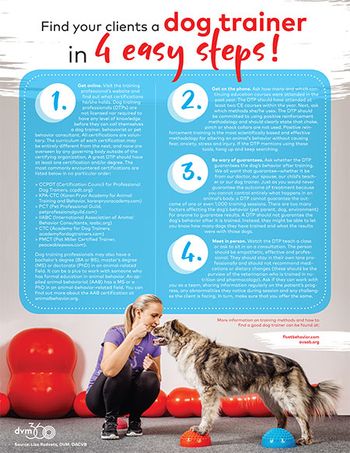
Heres a list of my favorite books and websites for veterinarians, veterinary team members and/or pet owners to cover the most common or difficult behavioral issues.

Dr. Radosta is the owner of Florida Veterinary Behavior Service in West Palm Beach, Florida. She completed a residency in behavioral medicine at University of Pennsylvania where she received two national research awards. She has authored textbook chapters; writes a column for the Palm Beach Post and podcasts CE for VetGirl. She has published research papers on thyroid disease and clinician client communication and has lectured across the country and internationally. She is the behavior section editor for Small Animal Advances in Medicine and Surgery, sits on the American Animal Hospital Association Behavior Management Guidelines Task Force and the Fear Free Advisory Board.

Heres a list of my favorite books and websites for veterinarians, veterinary team members and/or pet owners to cover the most common or difficult behavioral issues.

As a veterinary professional, you've probably witnessed poor training here, there, everywhere. Which is why you know that an experienced, qualified dog training professional is hugely valuable to dog owners and can make a world of difference for your canine patients. Use this tool to help lead veterinary clients in the right direction.

Dealing with pre-veterinary visit pharmaceuticals requires good decision making, excellent guidelines and, sure, just a touch of magic.

Puppies and kittens who exhibit straight-up fear or wont investigate stimuli after being startled are outliers in need of treatment, says Fetch dvm360 conference speaker and veterinary behaviorist Dr. Lisa Radosta.

The veterinary team plays a key role in helping de-escalate battles cats wage against their owners and other pets in the household.

Veterinary behaviorist Dr. Lisa Radosta shares tips for dealing with antagonistic tabbies.

You don't have to know everything! When you play to each other's strengths, you can ease pets' fears more effectively.

Help your veterinary clients understand the difference between safe, healthy play and aggressive, traumatic interactions.

Essentially we're asking about nature vs. nurture. Get a veterinary behaviorist's point of view on this eternal question.

Help veterinary clients get scared straight by pointing out signs in fear in their pets.

My path: Accept myself and hone my skills in the areas in which I excel to have the greatest impact, no matter what my role.

Two tactics that veterinary behaviorist Dr. Lisa Radosta wishes you would use to calm and redirect patients.

Dr. Lisa Radosta puts to rest a persistent myth surrounding an often-tricky veterinary task.

The single most important thing veterinarians can do when interacting with pets

Dr. Lisa Radosta presents three tools you can use to help pets be on their best behavior.

Published: August 25th 2013 | Updated:

Published: May 8th 2015 | Updated:

Published: December 1st 2015 | Updated:

Published: January 25th 2016 | Updated:

Published: February 19th 2016 | Updated:

Published: May 4th 2016 | Updated: